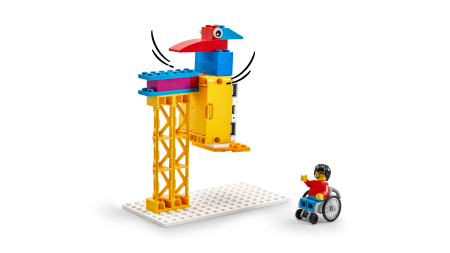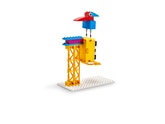Gravity
Daniel loves the way birds stay balanced, even when a branch moves. Help him make a model bird that can stay balanced too.

Prepare
(NOTE: This lesson contains a Part A and a Part B. Both are important to access the full learning of the standard. If time is limited, review both parts to choose elements that meet your students’ needs.)
In this lesson, students will build a balancing bird, using the example image(s) for inspiration. Encourage them to design and build their own idea for a balancing bird.
- Science Background - Gravity:
- The center of gravity of an object is where its weight is balanced. A low center of gravity helps keep objects stable.
- As students tilt the bird model, its average weight moves higher and it becomes less stable.
- The downward force of gravity will always pull the bird back so that its center of gravity is as low as possible.
- No matter how the bird is tilted, the gravitational force acting on it will pull it straight down towards Earth's center.
- Build Prior Knowledge - Gravity: Using your core science materials and the provided background, share information, images, and definitions.
- Forces are pushes or pulls that act in a specific direction.
- Gravity is a force exerted by Earth that pulls objects down toward the center of the planet.
- An argument supports a claim or statement about something that happens in nature (e.g., gravitational force exerted by Earth on objects is downward). It should include evidence like reasons, data like facts, and/or a model demonstrating observations.
- Key vocabulary: force, gravity
- Building and Programming Experience: Review the suggestions in the Unit Plan. For this lesson, you may also want to:
- Reinforce with the Gyro Sensor tutorial in the SPIKE App Start menu.
- Use the Event and Sound Blocks sections of the Help>Word Blocks menu in the SPIKE App to provide more support. See the Sensor Block>Is tilted? section for guidance on this sensor, which requires the Hub to be level when the base model is at rest.
- Use the High-Tech Playground lesson to provide experience with the Event Block.
PART A (45 Minutes)
Engage
(Whole Class, 10 minutes)

Introduce the story’s main character(s) and the first challenge: Help Daniel build a balancing bird model.
THINK—Facilitate a brief discussion about the lesson topic(s):
- What happens when you hold an object up in the air and let go? Why? (The object falls to the ground because the force of gravity pulls it down.)
- What happens when you pull back a swing or pendulum and let go? Why? (The swing returns to its lowest resting position because the force of gravity pulls it down.)
Distribute a SPIKE™ Essential Set and device to each group.
Explore
(Small Groups, 25 minutes)
As students work, consider sharing the examples below as support for building and programming. Clarify that the images show one idea and students should design and build their own balancing bird idea.
Have students:
- Use the base model to BUILD a balancing bird model for Daniel, showing that the downward force of gravity will keep the bird in its original upright position when tilted.
- Use the built-in Gyro Sensor with Event and Sound Blocks to PROGRAM their model to make different bird sounds when it is tilted to the right or to the left and when it is upright.
Facilitate brainstorming about ways to use LEGO elements to create a bird model that returns to its original upright position when tilted. As needed, demonstrate how the base model’s Hub hangs from a pivot point (e.g., a connector or axle), enabling it to move and return to its original upright position when tilted and released. Students may vary the base model as long as the Hub hangs from a single pivot point.
Halfway through work time, have students exchange ideas using a familiar classroom routine and then update their models with inspiration from sharing.
Example Ideas
.png?locale=en-us&auto=webp&format=jpeg&width=216&height=124&quality=90&fit=bounds)
.png?locale=en-us&auto=webp&format=jpeg&width=216&height=124&quality=90&fit=bounds)


Explain
(Whole Class, 10 minutes)
Gather students for sharing.
Have each group use their model to demonstrate and explain:
- The direction of the gravitational force on their bird (“toward the ground”)
- How gravity returns their model to its original position when it is tilted.
- How their program uses sounds to show the various positions of the bird.
If you wish to continue to Part B—Explain, have students keep their models intact or allow time for rebuilding.
PART B (45 minutes)
Explain
(Whole Class, 10 minutes)
- Repeat the steps from Part A - Explain to have additional groups demonstrate and explain their learning.
Elaborate
(Whole Class, 30 minutes)
- (5 min) Share and build background to help students Elaborate.
- Have students turn their birds 160 degrees (almost upside down) and let go.
- As needed, restate what they will discover:
- The Hub must be above the pivot point for the bird model to work because it naturally returns to its most stable position, which is to hang below the pivot point. The heavy weight above the pivot point is not stable as the force of gravity pulls the Hub back down.
- (10 min) Have students iterate and test their models to complete the next challenge in the app:
- Build a balancing bird model that does not include the Hub but stays upright, even when tilted. (Tip: Models should have the part of the bird below the pivot point weigh more than the part above.)
- Show that the bottom part of their bird is heavier than the top and explain why this must be true in terms of gravitational forces. (If the top part of the bird were heavier than the bottom part, the force of gravity would pull the heavier top down, flipping the bird over.)
- (15 min) Invite students to share knowledge, ideas, or skills that:
- Helped them complete the challenge.
- They learned while building.
- Have students clean up the sets and work areas.
Evaluate
(Whole Class, 5 minutes)
- Ask guiding questions to elicit students’ thinking and their decisions while ideating, building, and programming.
Observation Checklist
Review the learning objectives (Teacher Support box).
They support an argument that the gravitational force exerted by Earth on objects is downward.
Share specific student responses and behaviors at different levels of mastery.
Use the checklist to observe students’ progress:
- Their model includes a self-righting bird.
- Part A: Their explanation demonstrates that the gravitational force on the model acts downward. The heavy hub is pulled down by gravity, keeping the lighter parts of the bird on top.
- Part B: Their explanation demonstrates that the bottom half of the new bird must be heavier than the top half for the bird to remain upright. The Elaborate bird differs from the Explain bird in a significant way: it does not have the heavy hub below the pivot point to keep it upright.
Self-Assessment
Have each student choose the brick that they feel best represents their performance。
- Blue brick: I think I can follow instructions to create a program.
- Yellow brick: I can follow instructions to create a program.
- Green brick: I can follow instructions to create a program, and I can help a friend do it too.
Peer-Feedback
In their small groups, have your students discuss their experiences working together.
Encourage them to use statements like these:
- I liked it when you…
- I’d like to hear more about how you…
Differentiation
Simplify this lesson by:
- Stopping after the first challenge: Build a balancing bird model that includes the Hub in the lower half. Ask students yes/no questions to elicit their explanation.
Increase the difficulty by:
- Extending the Part A—Explore challenge: Have students build and program a different animal (not a bird) including the Hub as used in Part A so that it rights itself when tilted. Some examples include squirrels or monkeys.
Extension
- Provide learning materials about ways that varied objects, such as racing cars and drinking cups for babies, are designed to prevent tipping. Have students learn about one example and then share in writing, such as by developing a script for a video advertisement for a product.
If facilitated, this will extend beyond the 45-minute lesson.
Language Arts: CCSS.ELA-LITERACY.W.5.1
Teacher Support
Students will:
- Build a device that demonstrates that the gravitational force exerted by Earth pulls objects down, toward Earth’s center.
- Use the device to explain the bird’s behavior in terms of the downward force of gravity.
(one for every two students)
- LEGO® Education SPIKE™ Essential Set
- Device with the LEGO Education SPIKE App installed
Meet the team: Minifigure Bios
- NGSS 5-PS2-1: Support an argument that the gravitational force exerted by Earth on objects is directed down.
- CSTA 1B-AP-15
- NGSS 3-5-ETS1-1
- ISTE 1.4.c
- CCSS.ELA-LITERACY.SL.5.1
Language Arts Extension
- CCSS.ELA-LITERACY.W.5.2